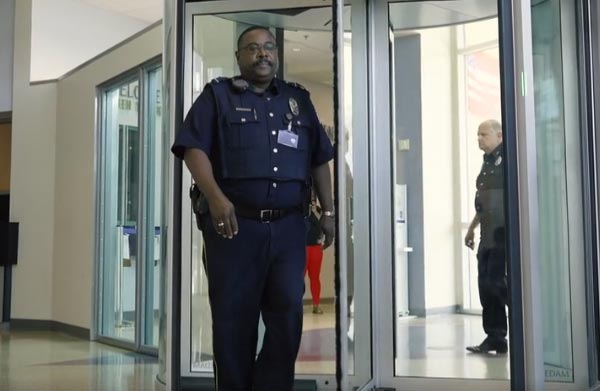
After securing the Jack Evans headquarters building with Tourlock security revolving doors in 2018, a new fence line with Turnlock 100 full-height turnstiles is installed to protect exterior police parking lots.
There is a saying that ?Everything is Bigger in Texas,? and the Dallas police department fits the bill. The Dallas Police Department is the ninth largest municipal police force in the U.S., with 3,099 sworn officers and 598 non-sworn staff. It is led by Chief of Police Edgardo (?Eddie?) Garcia.
In the last several years, the Jack Evans Police Headquarters building (named after the 53rd mayor of Dallas) has been upgrading its physical security using a layered approach to ensure the safety of officers and visitors 24/7. The most recent addition is a brand-new fence line fortified with vehicle gates and Boon Edam Turnlock full height turnstiles to control pedestrian access into secured parking areas.
Enhancing Security at the Jack Evans Headquarters Building
The Jack Evans Police Headquarters building was built in 2003. The six-floor facility has 358,000 square feet, and is spread over a three-acre site, with a separate 1,200 car parking garage and a two-acre, open parking lot for additional police and visitor parking.
The Headquarters building was under construction when 9/11 terrorists flew airplanes into the World Trade Buildings in New York. Therefore, security was a concern in its original design. Police officials worked with a Police Design Consultant ?McClaren, Wilson, and Lawrie Architects of Phoenix, AZ? to help design the building to resist a terrorist attack and isolate potential hazards. The building also needed to control visitor traffic and access. In an average month, there are 5,000 public visitors to the Jack Evans building.
An Active Shooter Incident Led to an Increase in Security
After midnight on June 13, 2015, a 35-year-old male placed a duffle bag with a remote-controlled bomb to detonate later between cars in the parking lot of the headquarters building. The suspect then began shooting continuously at the lobby windows with a rifle. Officers responded to the scene, a vehicle chase began, and the incident ended outside the city. Fortunately, officers in the lobby took cover and were not injured.
Following that incident, the Dallas Police Department conducted a security assessment of the building, and also at seven patrol stations throughout the city. The assessment included testing various construction materials for bullet resistance to various types of weapons. Gensler Architects and Guidepost Solutions, LLC developed the solutions and plans. Paul M. Schuster, Senior Corporal/Facilities Management, was responsible for managing implementation of the security upgrades.
?The police tend to be a symbol of government and some citizens see that as a visible target to lash out at,? says Schuster. Police officers are trained to expect the routine types of calls, such as domestic violence, traffic accidents, and other crimes. Yet they must be flexible to anticipate the non-routine that can be dangerous and change in a heartbeat. Yesterday we were concerned about handguns, today we are worried about rifles, and the idea of terrorism is always present with outright attack or bombs. The police officers and staff only want a place that is safe and where they can do their good work.?
Layer 1 ? Upgrading the Building?s Lobby Security with Detection and Prevention
In 2016, funding of $1.3 million was approved to upgrade the lobbies of the seven patrol stations to withstand rifle rounds, and $1.9 million to improve headquarters lobby security, and to upgrade an aging security system. Turner Construction Company and Convergint Technologies, LLC conducted the renovations and security technology integration.
The headquarters? lobby was initially built as a two-story glass-walled structure, with an information desk and public records service windows. Visitors could freely enter the lobby and were only screened in an open area to the side if going to the upper floors.
?The challenge in upgrading lobby security was the two-story lobby entrance glass. The glass was not bullet rated, due to budget constraints. Changing the front of the building to support ballistic rifle-rated glass would have caused extensive time, exposed the inside of the lobby to weather, and would not have solved all of the security issues. In addition, there were concerns about keeping an ?open? and friendly service concept in mind and ensuring that the lobby would not resemble a ?fortress?,? Schuster said.
Retain the original, two-story glass exterior
The solution was to retain the original, two-story glass exterior but add a layer of security inside once a person enters the lobby ? a new separate security screening room. A new interior wall with bullet-rated glass and solid bullet-resistant wall materials was constructed inside the lobby to channel visitors to the room. Now, all visitors must pass through a metal detector and have their belongings x-rayed prior to entering the original lobby. The room itself also has bullet resistant walls to enable containment of any violent disruption or shooting inside. Source: boonedam.com

